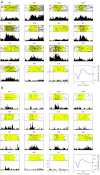Somatosensory responses in a human motor cortex
- PMID: 23343902
- PMCID: PMC3628033
- DOI: 10.1152/jn.00368.2012
Somatosensory responses in a human motor cortex
Abstract
Somatic sensory signals provide a major source of feedback to motor cortex. Changes in somatosensory systems after stroke or injury could profoundly influence brain computer interfaces (BCI) being developed to create new output signals from motor cortex activity patterns. We had the unique opportunity to study the responses of hand/arm area neurons in primary motor cortex to passive joint manipulation in a person with a long-standing brain stem stroke but intact sensory pathways. Neurons responded to passive manipulation of the contralateral shoulder, elbow, or wrist as predicted from prior studies of intact primates. Thus fundamental properties and organization were preserved despite arm/hand paralysis and damage to cortical outputs. The same neurons were engaged by attempted arm actions. These results indicate that intact sensory pathways retain the potential to influence primary motor cortex firing rates years after cortical outputs are interrupted and may contribute to online decoding of motor intentions for BCI applications.
Figures





Similar articles
-
Cortical reorganization following bimanual training and somatosensory stimulation in cervical spinal cord injury: a case report.Phys Ther. 2007 Feb;87(2):208-23. doi: 10.2522/ptj.20050365. Epub 2007 Jan 9. Phys Ther. 2007. PMID: 17213410
-
Congenital mirror movements. Abnormal organization of motor pathways in two patients.Brain. 1991 Feb;114 ( Pt 1B):381-403. doi: 10.1093/brain/114.1.381. Brain. 1991. PMID: 2004248
-
Cortical contributions to sensory gating in the ipsilateral somatosensory cortex during voluntary activity.J Physiol. 2017 Sep 15;595(18):6203-6217. doi: 10.1113/JP274504. Epub 2017 Aug 18. J Physiol. 2017. PMID: 28513860 Free PMC article.
-
Bidirectional brain-computer interfaces.Handb Clin Neurol. 2020;168:163-181. doi: 10.1016/B978-0-444-63934-9.00013-5. Handb Clin Neurol. 2020. PMID: 32164851 Review.
-
Integrated technology for evaluation of brain function and neural plasticity.Phys Med Rehabil Clin N Am. 2004 Feb;15(1):263-306. doi: 10.1016/s1047-9651(03)00124-4. Phys Med Rehabil Clin N Am. 2004. PMID: 15029909 Review.
Cited by
-
Multimodal Interactions between Proprioceptive and Cutaneous Signals in Primary Somatosensory Cortex.Neuron. 2015 Apr 22;86(2):555-66. doi: 10.1016/j.neuron.2015.03.020. Epub 2015 Apr 9. Neuron. 2015. PMID: 25864632 Free PMC article.
-
Detection of optogenetic stimulation in somatosensory cortex by non-human primates--towards artificial tactile sensation.PLoS One. 2014 Dec 26;9(12):e114529. doi: 10.1371/journal.pone.0114529. eCollection 2014. PLoS One. 2014. PMID: 25541938 Free PMC article.
-
Corticospinal excitability of tibialis anterior and soleus differs during passive ankle movement.Exp Brain Res. 2019 Sep;237(9):2239-2254. doi: 10.1007/s00221-019-05590-3. Epub 2019 Jun 26. Exp Brain Res. 2019. PMID: 31243484 Free PMC article.
-
Neural Representation of Observed, Imagined, and Attempted Grasping Force in Motor Cortex of Individuals with Chronic Tetraplegia.Sci Rep. 2020 Jan 29;10(1):1429. doi: 10.1038/s41598-020-58097-1. Sci Rep. 2020. PMID: 31996696 Free PMC article.
-
Neurophysiology and neural engineering: a review.J Neurophysiol. 2017 Aug 1;118(2):1292-1309. doi: 10.1152/jn.00149.2017. Epub 2017 May 31. J Neurophysiol. 2017. PMID: 28566462 Free PMC article. Review.
References
-
- Albe-Fessard D, Liebeskind J. Origine des messages somatosensitifs activant les cellules du cortex moteur chez le singe. Exp Brain Res 1: 127–146, 1966 - PubMed
-
- Benjamini Y, Hochberg Y. Controlling the false discovery rate: a practical and powerful approach to multiple testing. J R Stat Soc Series B Methodol 57: 289–289, 1995
Publication types
MeSH terms
Grants and funding
LinkOut - more resources
Full Text Sources
Other Literature Sources

